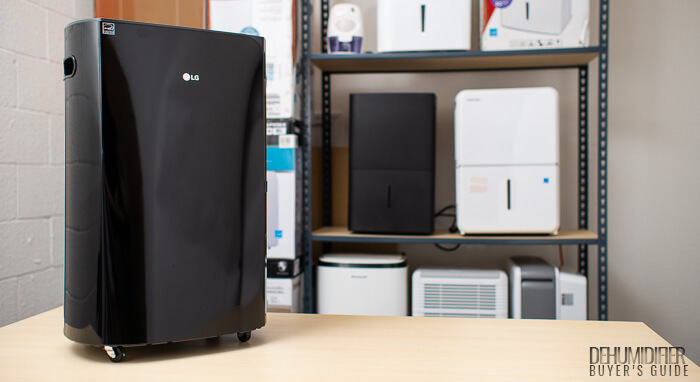
- Features a pleasant noise output profile
- Comes equipped with a highly accurate built-in hygrometer
- One of the most durable units we’ve tested
- Its tank’s removable lid is a useful feature that allows for easier and quicker emptying
- Poor performance in some of our most important hands-on tests
- Requires a drainage adapter for gravity drainage
- Has a small water tank
- Dehumidifier
- Gravity Drain Adapter
- Instruction Manual
| Energy Efficiency | 2.5 |
| Noise Output | 4.0 |
| Moisture Removal | 2.0 |
| Hygrometer Accuracy | 4.5 |
| Durability | 5.0 |
| Adjustability | 3.0 |
| Versatility | 3.0 |
| Extra Features | 4.5 |
| Ease of Use | 4.0 |
| Portability | 3.0 |
| Warranty | 3.5 |
| Value | 3.0 |
| Editor's Score | 3.5 |
Quick Review Summary
We tested the LG UD501KOG5 for this review. But note that much of the same review also applies to its built-in pump equivalent, the UD501KOJ5. The UD501KOJ5 is all but identical to the UD501KOG5 except for the fact that it adds a built-in pump. Thus, all that we discuss regarding the UD501KOG5’s energy efficiency, moisture removal rate, etc. also applies to the built-in pump equivalent, the UD501KOJ5 .
Between these two models we strongly recommend the non-built-in pump UD501KOG5. If you want to add pump functionality simply purchase a condensate pump separately. Built-in pumps on dehumidifiers are known for failing early. The quality of a built-in pump is usually nowhere close to that of a highly rated separate condensate pump. The same is very likely to apply to the UD501KOJ5. It’s too early to see consumer reviews complaining of early pump failure for this particular model (since it’s brand new to market, at least right now) but we invite you to read consumer reviews for any other built-in pump dehumidifier that’s been on the market for at least a few years. All of them are littered with complaints of early pump failure.
In any case, the non-built-in pump LG UD501KOG5 was one of the more disappointing dehumidifiers we tested. When we first unboxed this unit, its terrific build quality suggested that it had a good chance of being one of the best dehumidifiers we would test in 2020. However, this couldn’t have been further from the truth. Our hands-on testing revealed that this unit’s performance is nowhere close to that of top rated units in many important categories. We discuss its shortcomings (and all of the positives for this unit) in detail in the review below.
Note that we wrote most of the review below when the Frigidaire FFAD5033W1 was our top pick, before we tested the Midea Cube. For this reason, we mostly compare the LG UD501KOG5 to the Frigidaire FFAD5033W1 (and not the Midea Cube) in this review.
Performance Test Results
Energy Efficiency
The LG had a slightly higher power draw than most other 50 pint dehumidifiers we tested. It was measured at 586 watts. Most other units in this size class (50 pint), including the top rated Frigidaire FFAD5033W1, were measured at approx. 570 watts.
The LG performed very poorly in our moisture removal testing. It took much longer than most other 50 pint units we tested to lower room humidity from 90% down to 40% relative humidity (RH) in our 50 sq. ft. test space.
Thus, the LG not only draws slightly more power, but it also takes a longer period of time to dehumidify than most other 50 pint units we tested. This combination of high power draw and low moisture removal rate gives the LG poor energy efficiency according to our testing.
Noise Output
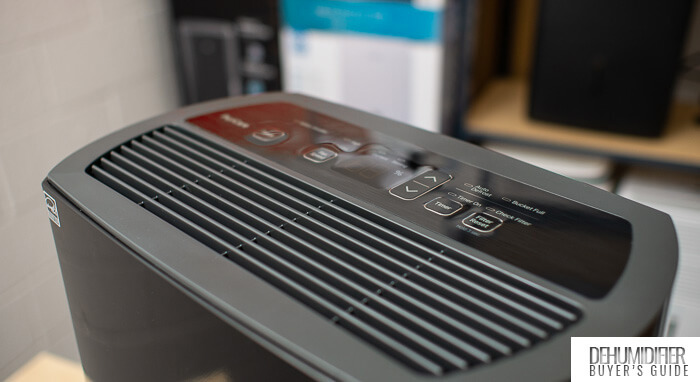
Dehumidifiers makes two different types of noise – a compressor noise and a fan noise (not of the fan rotating but of the fan pushing air through the unit’s exhaust).
Compressor noise is an unpleasant buzzing noise. Fan noise is a far more pleasant white noise.
Again, every dehumidifier makes some combination of these two noises. How much it makes of each determines the unit’s noise output profile. If compressor noise is loud enough to pierce through fan noise it makes for an unpleasant noise output profile. Conversely, if the fan noise is loud enough to mask compressor noise it makes for a more pleasing noise output profile.
Generally, top exhaust units do a better job of masking compressor noise as they distribute fan noise more omnidirectionally. Side exhaust units distribute fan noise in a single direction – whichever way the exhaust is facing. And unless you’re in the direct path of that direction, compressor noise isn’t masked nearly as well as it is in a top exhaust unit.
The LG is a top exhaust dehumidifier and so it masks compressor noise very well. The compressor noise is very pronounced on low fan speed (much like it is on most other dehumidifiers we’ve tested) but on high fan speed the upward facing exhaust distributes the fan noise very well throughout the room to properly mask any and all compressor noise.
In terms of raw noise output, the LG was measured at 53.8 dB on high and 49.8 dB on low 10 ft. away from the dehumidifier. For comparison, the top rated Frigidaire FFAD5033W1 was measured at 54.6 dB and 49.8 dB in the same test. The hOmeLabs HME020031N was measured at 50.3 dB and 48.8 dB.
Of the three, the Frigidaire was the “loudest” but has a quieter compressor than both the LG and hOmeLabs and so it produced the most pleasing noise output profile.
The hOmeLabs was the “quietest” but its side exhaust made for the least pleasing noise output profile.
The LG sits somewhere in the middle – it’s louder than the hOmeLabs but produces a more pleasing noise output profile. It’s quieter than the Frigidaire but doesn’t produce as pleasing of a noise output profile.
Moisture Removal
As we mentioned earlier, the LG UD501KOG5 was a poor performer in our moisture removal testing. In these tests we measure how long it takes the dehumidifier to lower room humidity from 90% down to 40% RH in the first test and 80% down to 50% RH in the second test. All tests are conducted in only 50 sq. ft. to limit the time it takes to conduct each test and allow us to conduct multiple trials for each unit we test.
The LG took, on average, 14 minutes and 31 seconds to lower room humidity from 90% down to 40% RH. The hOmeLabs took 10 minutes, 3 seconds and the Frigidaire took only 7 minutes, 56 seconds. Most 50 pint units we tested took about 10 to 11 minutes. Thus, the LG was a well below average performer in this test.
The LG took, on average, 7 minutes and 37 seconds to lower room humidity from 80% down to 50% RH. Again, the hOmeLabs (5 minutes, 33 seconds) and Frigidaire (5 minutes, 19 seconds) took less time. The average for the 50 pint size class (among units currently on the market) is about 6 minutes. And so the LG was also a well below average performer in this second test.
Hygrometer Accuracy
When it comes to hygrometer accuracy, the LG functions and performs much the same as the Frigidaire. Both units only display the current room humidity in 5% increments and both units were about as accurate (±2%) as they could be within this limitation.
Most other 50 pint units we tested displayed current room humidity in 1% increments. This alone allows for more accuracy than a display that only show room humidity in 5% increments. That being said, most “1% increment” units weren’t any more accurate than the LG and Frigidaire. The hOmeLabs, for example, was ±3% accurate. The most accurate hygrometer belonged to the Honeywell – it measured room humidity to within 1% of the actual room humidity.
Included Features, Functionality, Build Quality, Warranties, and Value
Durability (Build Quality)
General Impressions
The UD501KOG5 is very well built. It’s also made of very high quality parts. If you were to compare this unit side by side with many of the other 50 pint units we tested, you’d immediately see the difference in build quality and quality of materials – the LG is better built with better quality parts. The only other unit we tested that’s as well built with the same level of quality used for its parts was the top rated Frigidaire FFAD5033W1.
Both the Frigidaire (on the right below) and LG stand head and shoulders above the competition in terms of build quality and quality of materials used for their construction.
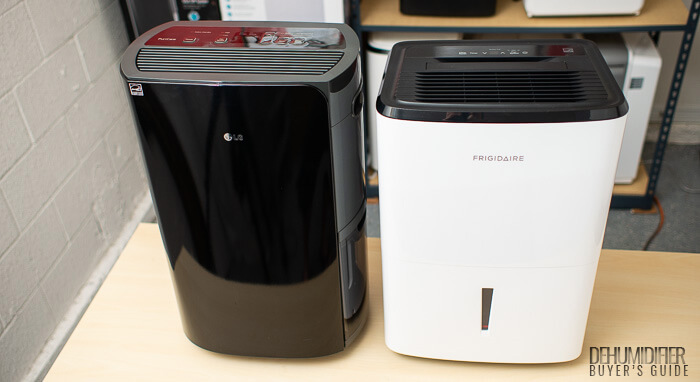
Consumer Feedback
This unit is, as of the writing of this editorial review, essentially brand new to market. As such, it hasn’t received many consumer reviews. And those that it has received don’t apply in this category.
Usually, we look for consumer reviews written at least 1 to 2 years after purchase to see if there are any complaints about long term reliability.
We can’t do that with the LG at this time because it even been on the market for a full year as of the writing of this review.
Overall Category Score
Despite a lack of consumer feedback we’re confident the LG will offer great long term reliability because of its excellent build quality. It earns a perfect 5/5 in the category.
Adjustability
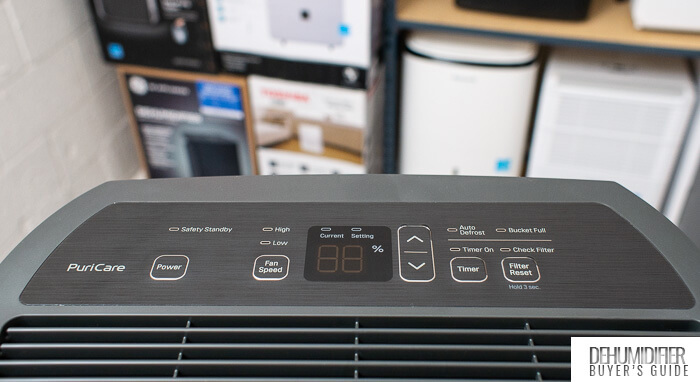
The LG UD501KOG5 is limited in this category.
Its timer can only be set in 1 hour increments up to 12 hours. Most other 50 pint units have timers that can be set for up to 24 hours.
The LG doesn’t feature a continuous mode. Most other 50 pint units do offer this mode.
The LG only comes with 2 fan speeds. A few other 50 pint units (like the Frigidaire) come with 3. That being said, you’ll rarely want to use anything other than high fan speed. High fan speed allows for faster moisture removal and it produces a more pleasing noise output profile (fan noise better masks compressor noise).
The LG allows you to set a desired humidity level in 5% increments, just like every other 50 pint dehumidifier we’ve tested (at least in the last several years).
Overall Category Score
The LG earns a below average 3/5 in the category.
Versatility
Set Humidity Range
The UD501KOG5 allows you to set a desired humidity level between 30% and 80% RH. The 30% number is especially interesting. Most other 50 pint units we tested only allow you to set humidity as low as 35%. With such units you can set them to continuous mode to dehumidify past 35% but they won’t cycle off automatically when they reach lower humidity levels on the same (continuous) mode.
The LG doesn’t offer continuous mode but it does allow you to set a slightly lower humidity level of 30%. And it will automatically cycle off when room humidity reaches 30%.
Operating Temperature Range
41° F to 90° F – just like most other 50 pint units on the market.
Gravity Drainage
You do need to install an adapter to employ gravity drainage on this unit. With top rated units (like the Frigidaire) all you have to do is twist off a cap on their back drain outlet and connect a garden hose. With the LG you have to install an adapter first. It’s possible to lose this adapter and if that happens you won’t be able to drain the unit without replacing the part.
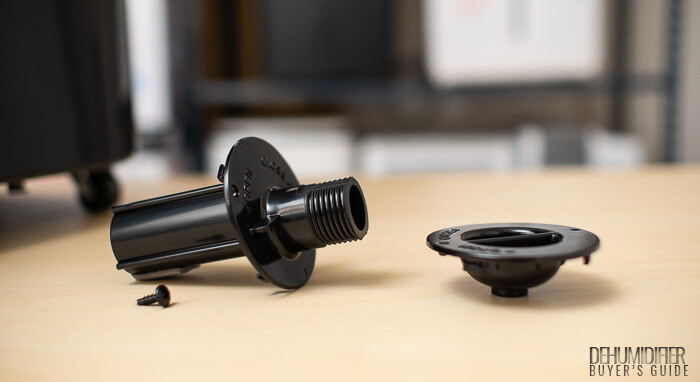
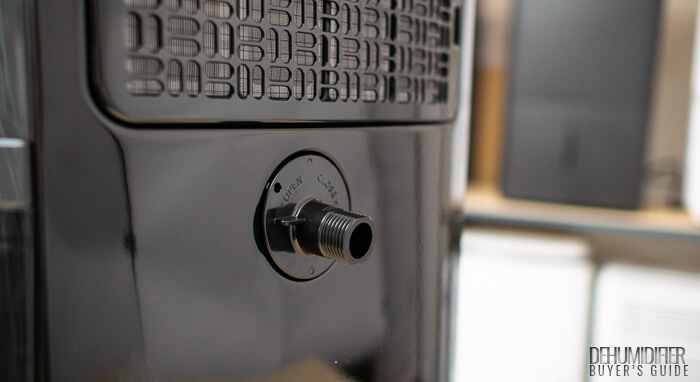
Built-in Pump
The UD501KOG5 doesn’t offer a built-in pump but LG does offer a built-in pump equivalent – the UD501KOJ5. Both models are essentially identical except for the latter model’s built-in pump.
Overall Category Score
The LG again earns a below average 3/5 in the category.
Extra Features
Temperature Reading
This unit does not display current room temperature. But neither do all of the other 50 pint units we’ve tested in recent years (this is more of a feature that was common in older units).
Defrost
This unit features a defrost mode and a defrost indicator light. The light is useful as the unit won’t be actively dehumidifying while defrost mode is activated (it will be defrosting instead). The fan still runs on defrost mode and so you might think the unit is running without dehumidifying – and that that is a problem. The defrost indicator light allows you to not make that mistake. The light shows that the unit is working just fine even though it’s not actively dehumidifying while in defrost mode.
Check Filter
This unit does feature a check filter light.
Overall Category Score
The LG earns a 4.5/5 in the category, mostly due to its inclusion of a defrost light.
Ease of Use
LED Display Clarity
This unit features a high quality LED display that’s easy to read, even from a slight distance.
Setup Difficulty
We have no complaints here.
Filter Removal Difficulty
The unit’s filter is accessed by removing the grille on the back of the unit. The grille holds the filter. Note that the two are not combined – they are two separate parts. This is not the case for many other dehumidifiers we’ve tested. Many units combine the two parts into a combination grille/filter.
Manual Clarity
The unit’s manual is well written and properly illustrated.
Water Tank Size
The LG offers a below average size water tank. Its tank capacity is only 13.3 pints. Most other high capacity dehumidifiers we’ve tested offer a tank capacity of at least 14 pints. The top rated Frigidaire has a tank with a capacity of 16.9 pints.
Most dehumidifiers have some type of a “splash guard” plastic “lid” that fits over the top of their water tanks. This plastic “lid” prevents spilling when you take out the tank to empty it. But it also limits how quickly you can empty the tank because there’s usually only a small hole through which you can empty the tank.
The LG’s tank also come with a splash guard “lid” but the lid is removable. And so you get all of the benefits of “splash guarding” while still being able to remove the lid when it comes to emptying the tank. And when you remove the lid you can empty the tank more quickly.
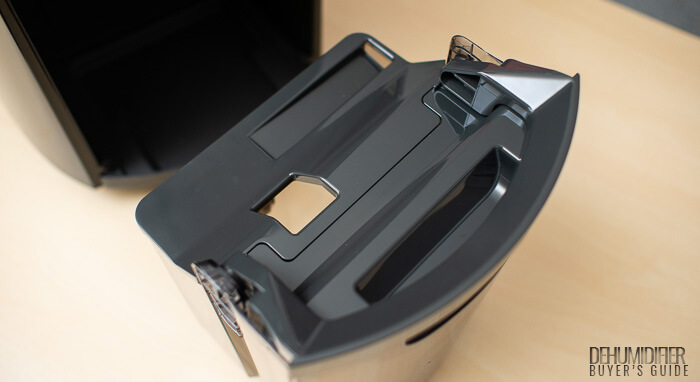
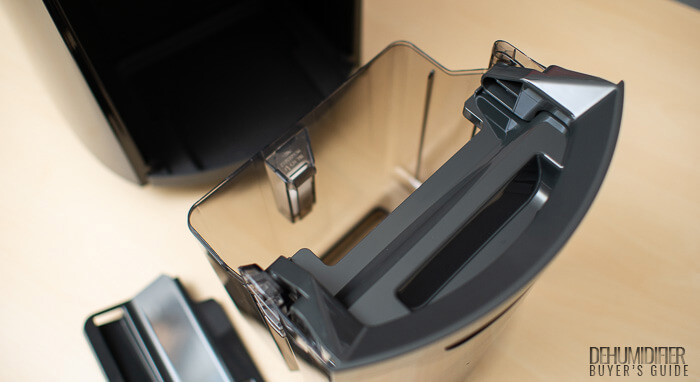
Overall Category Score
We really like the removable lid of this unit’s water tank. And so the LG scores an above average 4/5 in the category despite its smaller than average tank capacity.
Portability
The UD501KOG5 is a large appliance. It’s slightly taller (26.2 inches) than most other 50 pint units we tested (24 inches tall on average). It’s just about as wide (approx. 16 inches) and deep (approx. 12 inches) as most other 50 pint units.
It weighs 43.9 lb. The average weight for the size class (50 pints/day) is about 43 lb.
The unit features side pocket handles like many other 50 pint units on the market (such as the hOmeLabs). During testing we did find that a top extendable handle (such as the handle of the top rated Frigidaire) makes a dehumidifier easier to pick up and move around than side pocket handles.
The LG has no cord storage. The Frigidaire’s power cord can be wrapped around two hooks on the back of the unit. The hOmeLabs’ power cord can be wrapped around a plastic buckle on the back of the unit. The LG doesn’t have hooks or a buckle.
Overall Category Score
The LG is big, heavy, only has side pocket handles, and it doesn’t feature any cord storage. It’s not a good option if portability is a priority for you and so earns a below average 3/5 in the category.
Warranty (Manufacturer’s)
This unit features an industry standard 1 year warranty. The Frigidaire also features a 1 year warranty.
The hOmeLabs is one of only a handful of units that come with a longer warranty – the hOmeLabs comes with a 2 year warranty that can be extended by an additional 6 months if you register your purchase with the manufacturer.
Value
The LG tends to be priced considerably higher than most other 50 pint dehumidifiers we tested. And other than exceptional build quality, it doesn’t offer much to justify its (usually) higher price tag. We give it a below average 3/5 for value.
Have a question or comment? Let us know below.
need a filter replacsement.
I agree with everything in the review but would like to note one annoying feature of the unit: the chime. When the tank is full the LG ud501koj5em emits a very loud chime. There is no volume control. It cannot be turned off. I’ve confirmed this with LG support. I utilize the built-in pump so there is no need for the chime going off at all hours of the day and night. With the LG ThinQ app I receive notifications that log when the tank is full so I have a record of how frequently it is filling if I needed to know that for some reason. So why the chime? For an otherwise fairly well thought out construction, this is a design flaw. I have several other LG appliances, all with musical alerts. All can be adjusted or shut off.
Any hacks for deactivating the chime would be greatly appreciated.
Are the evaporator coils aluminum or copper?
Other dehumidifiers I’ve purchased only last 2 seasons because of “worm hole corrosion” of the evaporator tubing
Do you have a part number for the drainage hose adapter with screw?
I contacted LG for the part number of the drainage hose adapter with screw and they indicated the following part #: AEM75512901. They also recommended to me a series of appliance parts providers and I was able to make a purchase decision between them. I would recommend you reach out to LG Customer Service so they could recommend parts providers in your region.
Bought this LG UD501KOG5 about two weeks ago. It is set at 45% and has not stopped running since installation. Is this normal?
No, the unit’s compressor should cycle off once room humidity reaches 45%.
Did you test Tosot Model ECH3014570P by any chance?
Any comments?
No, we unfortunately haven’t tested any Tosot models yet.